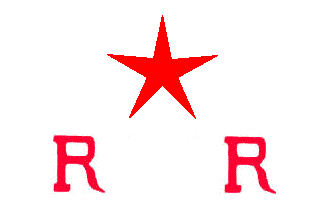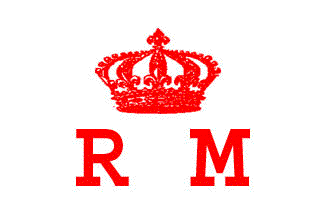 image sent by
Ivan Sache, 07 Mar 2009
image sent by
Ivan Sache, 07 Mar 2009
Last modified: 2015-05-20 by bruce berry
Keywords: merina | madagascar |
Links: FOTW homepage |
search |
disclaimer and copyright |
write us |
mirrors
An overview of early historical Malagasy flags is given at this
website, the main details of which are given below.
 image sent by
Ivan Sache, 07 Mar 2009
image sent by
Ivan Sache, 07 Mar 2009
Adoption of the first flags in Madagascar followed the contact of the
different kingdoms with foreigners, especially Europeans. In their
contacts with all kinds of traders, including slave merchants, the
islanders became familiar with flags hoisted on the ships owned by the
"Vazaha" ("Europeans").
The Sakalava of Antalaotra, an Islamic people living on the north-western coast of
Madagascar, used for a considerable period flags that were divided horizontally
red-black-white. Their dhows flew only one of these colours, charged
with Arabic script.
On the eastern coast, Jean René, King of Tamatave (Betsimisaraka
people), flew his own colours. In 1817, he pledged allegiance to the
Merina king Radama I, who granted him the title of "Andriambaventy"
and allowed him to keep his flag. Jean René's flag was white with a rooster holding a bunch of assegais in
its claws in the centre. The flag was manufactured in Rochefort (France).
Later, with the permission of the Ministry of
the Royal Navy, these flags were subsequently charged with the Union Jack in
canton, to denote the English presence in Mauritius.
The Merina kingdom became familiar with European traders' flags during
the reign of king Andrianampoinimerina. The Crown Prince, later King
Radama I, had two standards:
- a white flag, called "Mahazovola" ("providing money"),
with white being
the colour of the Royal idol ("sampy") Kelimalaza; and a
- a red flag, called "Mahazotany" ("providing land"), red being the
colour of the Royal idol Manjakatsiroa.
 image
sent by Ivan Sache, 07 Mar 2009
image
sent by Ivan Sache, 07 Mar 2009
In 1810, Radama succeeded his father and adopted a flag made of the
two colours placed horizontally.
Radama also used other flags. In 1816, Captain Lesage, Ambassador of
the British monarch, presented to Radama a purple flag with golden
Arabic scripts, a crescent, a hand of Fatima and a curved sword. In 1824 Radama seized the town of Majunga and appointed his cousin
Ramanetaka as the local ruler and ordered him to hoist a white flag
charged with a red star and the red letters "R R" ("Radama Rex", in
Latin for "King Radama").
 image by
Ivan Sache, 07 Mar 2009
image by
Ivan Sache, 07 Mar 2009
All subsequent Merina sovereigns (Ranavalona I, Radama II, Rasoherina,
Ranavalona II, Ranavalona III) used white and red flags, with
different arrangements of the colours, and the red letters "R
M" ("Rasoheri Manjaka", "Ranavalo Manjaka") surmounted by the Royal
crown.
 image by
Ivan Sache, 07 Mar 2009
image by
Ivan Sache, 07 Mar 2009
In 1895, the French colonial troops, commanded by General Duchesne, marched on Antananarivo. On 30 September 1895, a bomb planted by the French expeditionary corps destroyed the roof of the Royal palace ("Rova"); the white part from the Royal flag was cut off and hoisted as a sign of surrender. Queen Ranavalona III was maintained on the throne but the flag was changed to a French tricolor flag with a crowned monogram "R M" placed on the white stripe. On 28 February 1897, Governor General Galliéni exiled the queen to the Réunion island; the bronze eagle was removed from the top of the Royal palace and replaced by the French national flag.
As a French Protectorate between 1885-1896 Madagascar flew a distinctive flag
which is described and illustrated here.
Chrystian Kretowicz and Ivan Sache, 07 Mar 2009